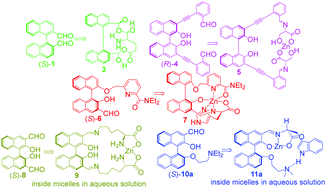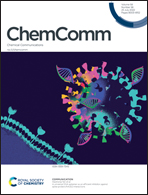Chemoselective and enantioselective fluorescent identification of specific amino acid enantiomers†
Abstract
The enantiomers of chiral amino acids play versatile roles in biological systems including humans. They are also very useful in the asymmetric synthesis of diverse chiral organic compounds. Therefore, identifying a specific amino acid and distinguishing it from its enantiomer are of great importance. Although significant progress has been made in the development of fluorescent probes for amino acids, most of them are not capable of conducting simultaneous chemoselective and enantioselective detection of a specific amino acid enantiomer. In this article, several fluorescent probes have been designed and synthesized for chemoselective as well as enantioselective recognition of certain amino acid enantiomers. (S)-1 shows greatly enhanced fluorescence in the presence of L-glutamic acid and L-aspartic acid, but produces no or little fluorescence response toward their opposite enantiomers and other amino acids. (R)-4 in combination with Zn2+ shows greatly enhanced fluorescence in the presence of L-serine. (S)-6 is designed for the selective recognition of histidine. Micelles made of an amphiphilic diblock copolymer are used to encapsulate the water-insoluble compound (S)-8 which shows chemoselective as well as enantioselective fluorescence enhancement with L-lysine in the presence of Zn2+ in aqueous solution. The same micelles are also used to encapsulate several (S)-1,1′-binaphthyl-based monoaldehydes (S)-10 for the chemoselective and enantioselective fluorescence recognition of L-tryptophan in the presence of Zn2+ in aqueous solution. These findings have demonstrated that highly selective fluorescence identification of a specific amino acid enantiomer can be achieved by incorporating certain functional groups at the designated locations of the 1,1′-binaphthyls. The binaphthyl core structure of these probes provides both a chirality source and highly tunable fluorescence properties. Matching the structure and chirality of these probes with those of the specific amino acid enantiomers can generate structurally rigid reaction products and give rise to greatly enhanced fluorescence. The strategies of this work can be further expanded to develop fluorescent probes for the specific identification of many amino acids of interest. This should facilitate the analysis of chiral amino acids in various applications. The outlook of this research and its comparison with other methods are also discussed.



 Please wait while we load your content...
Please wait while we load your content...
